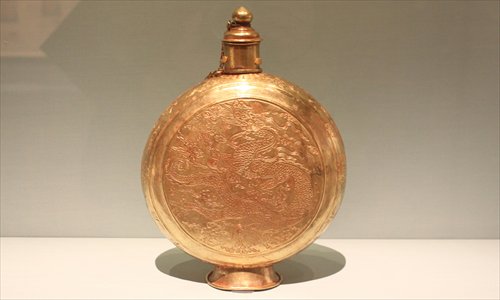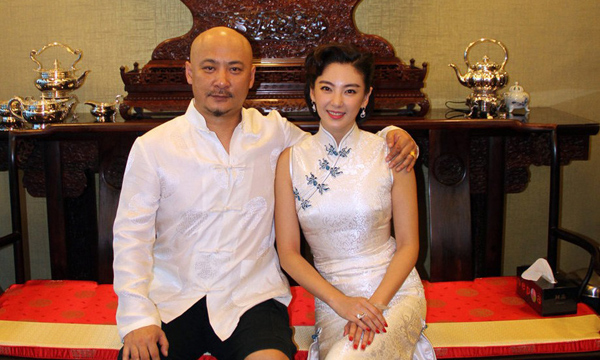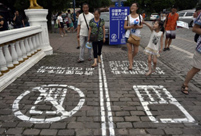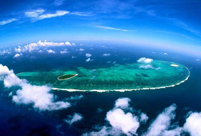 Vintage cars show kicks off in London
Vintage cars show kicks off in London
 Gorgeous scenery in NE China
Gorgeous scenery in NE China
 Picturesque Barkol grassland in Xinjiang
Picturesque Barkol grassland in Xinjiang
 Small Wild Goose Pagoda - A World Cultural Heritage Site along the Silk Road
Small Wild Goose Pagoda - A World Cultural Heritage Site along the Silk Road
 Maritime Silk Road Luxuries of the Han Dynasty
Maritime Silk Road Luxuries of the Han Dynasty
 Ciao! Chinese beauties!
Ciao! Chinese beauties!
 An eye feast: BFA freshmen registration
An eye feast: BFA freshmen registration
 Top 10 most lavish weddings
Top 10 most lavish weddings
 Most amazing chi-pao beauties
Most amazing chi-pao beauties
 Chinese lingerie brand arrives in Las Vegas
Chinese lingerie brand arrives in Las Vegas
 |
| A 15th century golden canteen with imperial dragon design (Photo: Sun Wei/GT) |
The British Museum opened its newest exhibition, Ming: 50 Years that Changed China, on Thursday, exploring the rich art and global influence of China's Ming Dynasty (1368-1644) during the early 15th century.
Five years in the making, the exhibition features some 280 objects. It's here that you can discover that blue-and-white Ming vases, a famous symbol of the dynasty, are actually only the tip of the iceberg of the culture from that time period. A varied collection, from gold vessels, red lacquer furniture, silk robes, calligraphy, to nine-meter-long scrolls painted on bamboo, give a snapshot of what it was like to be in China during that period.
Aside from a brief historical and contextual introduction at the beginning of the exhibition, you can also enjoy five different sections that form a vivid picture of China: court life, the art of war, the art of peace, trade and diplomacy, and beliefs.
This is the first exhibition at the museum that explores the great social and cultural changes in China that established Beijing as a capital city with the Forbidden City at its heart.
"It's not an exhibition of treasures, but a slice of Chinese history, roughly from 1400 to 1450," said the exhibition's co-curator Jessica Harrison-Hall.
The exhibition is set to overturn the idea that China awoke with the arrival of Europeans in the 16th century, and only later becoming internationally engaged. Instead, the exhibition shows the wealth of China's international reach around 100 years prior.
Through beautiful gold antiques, textiles, paintings, weapons and so on, the exhibition reveals that China was truly multicultural as early as the beginning of the 15th century, and that the courts were at the heart of that engagement, Harrison-Hall added.
Pivotal period
Between 1400-50, Ming China was the largest state in the world run by a single family through a vast administrative network.
"We picked this particular period because it's sandwiched between two very dramatic events: the civil war that brings [the] Yongle [Emperor] to power from 1399 to 1402, and the capture of the Zhengtong Emperor (AKA Emperor Yingzong) in 1449," said Harrison-Hall.
This period is particularly important for two reasons: one the courts and second global contacts. These 50 years witnessed the move of the capital from Nanjing to Beijing, where it stayed for the next 600 years, and the construction of the Forbidden City. This is also the period during which Admiral Zheng He sailed ships from Nanjing to South Asia, Southeast Asia, the Middle East and even the east coast of Africa. The country became closely connected with the world through trade, warfare, and cultural and religious exchanges. China's internal transformation and connections with the rest of the world led to a time of flourishing creativity.
"We are not saying these are the most important 50 years in Chinese history. The point is to make people outside China stop thinking about a very big chunk of Chinese history, and start to know more details and become more focused on a short period," Craig Clunas, Professor of Art at the University of Oxford, told the Global Times.
Major things happened in these 50 years that had a lasting impact, according to Professor Clunas. Some of them such as the move of the capital had a lasting influence throughout the Ming and Qing (1644-1911) dynasties.
"Imagine in the 18th century, when the [Qing Dynasty] Qianlong Emperor wants fabulous porcelain, what does he look for? What kind of porcelain was he imitating? He went back to [the Ming Dynasty] Xuande [Emperor]," Clunas said, adding that porcelain from the Xuande period is still the most expensive type sold at auctions.
Unprecedented global contacts
The underlying theme of the exhibition is international engagement, Jessica Harrison-Hall told the Global Times, adding that the opening of the exhibition fell on the 600th anniversary of the presentation of a giraffe to the Yongle Emperor.
The giraffe was sent by the ruler of Bengal, Saif al-Din Hamzah Shah, to cement his nation's relationship with the Ming court. The event was depicted on a hanging scroll titled Tribute Giraffe with Attendant, which is now part of the exhibition. Some at the time believed the giraffe was the mythical qilin, a beast that only appears when a sage sits on the throne. The giraffe joined a menagerie of exotic creatures kept at the palace, such as bears, rhinoceroses, elephants and peacocks.
The giraffe was just the tip of the iceberg of the early Ming's global contacts. During those 50 years, there was unprecedented contact with the world through embassies, an assertive military policy and court-sponsored maritime expeditions. China enjoyed a period of unprecedented global contacts from Kyoto to Mogadishu through trade and diplomacy.
Luxury goods from China such as porcelain, silk and spices were exchanged for gems from India, gold and exotic animals from Africa, glass and metal work from the Middle East, and spices and wood from Southeast Asia.
In a painting by Italian artist Andrea Mantegna (1431-1506) located at the end of the exhibition, the artist depicts the nativity scene of three wise men paying homage to baby Jesus. One of the men is seen presenting a blue-and-white Ming porcelain bowl filled with gold. This is the earliest known representation of Chinese blue and white porcelains in Europe. The bowl is depicted with a delicate floral motif similar to those made at the imperial factory at Jingdezhen during the reign of the Yongle Emperor. An almost identical bowl is displayed alongside the painting.
New perspective
"Everything here is here for a purpose," said Craig Clunas.
Among them, a third are from British museums, a third from 10 separate museums in China and the rest from 21 museums in other countries. Many of them have only very recently been discovered and have never been seen outside China.
The exhibition sheds light on an important part of world history that is little known in Europe. Old histories of China tend to over-emphasize its contact with Europe after 1500. However, this exhibition highlights the complex and longer-lasting intra-Asian connections that played a key role in the formation of the Chinese state, society and culture.
At the same time, the exhibition explores the diversity within the Empire itself, enabling those unfamiliar with China's history to become more aware of the diversity within the government structure of the time.
Neil MacGregor, director of the British Museum, said, "The political, social and cultural changes to China during the first half of the 15th century make this a remarkable story which is only now being fully understood. New discoveries and research have led to a new perspective on this significant period that moves away from a Euro-centric view of China's history."
The exhibition runs from September 18 to January 5.
 Giant white gourd weighing 87 kilograms appears in SE China
Giant white gourd weighing 87 kilograms appears in SE China Advanced arms help to safeguard China-ASEAN Expo
Advanced arms help to safeguard China-ASEAN Expo Leading director Wang Quan'an detained for 'buying sex'
Leading director Wang Quan'an detained for 'buying sex' Heaven on earth: Dongjiang Lake in Hunan
Heaven on earth: Dongjiang Lake in Hunan Mixed reaction to smartphone sidewalk
Mixed reaction to smartphone sidewalk 'Rainbow running' race in Jiangxi
'Rainbow running' race in Jiangxi Amazing aerial photos of China's Xisha Islands
Amazing aerial photos of China's Xisha Islands Beautiful postgraduate teaches in remote area
Beautiful postgraduate teaches in remote area Top 10 world's highest-paid models 2014
Top 10 world's highest-paid models 2014 Lingerie show at 2014 Miss China
Lingerie show at 2014 Miss China Songstress Li Xianglan dies at 94
Songstress Li Xianglan dies at 94 Police recruiting posters
Police recruiting posters Anshun Daxi- Living fossil of Chinese drama
Anshun Daxi- Living fossil of Chinese drama Urban farmers in China
Urban farmers in China 'Firepower-2014 Weibei'military exercise
'Firepower-2014 Weibei'military exerciseDay|Week|Month